Still thinking of what to give that special someone for Christmas? Recently I spent the day at the De Young Museum enjoying the Renaissance paintings on loan from Venice, Italy. Also got over the The Palace of Fine Arts for the exhibit of the the Impressionist, Passarro.
The paintings are powerful and inspiring. I was especially drawn to the landscapes. Looking at the pomegranate, olive and apple trees gave me some ideas for holiday presents.
Because Venice was literally built on a forest of tree trunks driven into the mud of a marsh it's geography is unique. In a city built on water, plants were highly valued and nurtured on terraces and courtyards. There was a longing for natural settings and this is clear in the the Renaissance painters work. Mediterranean plants from the mainland were brought over to grace the houses of the wealthy. Laurel trees, signifying purity and chastity, are often depicted in these masterpieces.
What a great gift one of these masterpieces would make. But what if you don't have millions to buy an original? Here are some other ideas to consider.
The landscapes depicted in many of the paintings inspired me to work on my Christmas list. I'm a gardener starved for color, life and greenery. It was 29 degrees in my garden in Felton this morning and I know many of you experienced even colder temps after the brightness of the stars on a clear overnight sky.
Thick frost finished off this year's garden- what was left after the wind storm anyway. Even the more sheltered places look a little winter weary this year. Winter is here a tad early for our California gardens. Make the most of those empty spaces in your garden and those of the fellow gardeners you'd like to remember during the holidays.
Are your containers looking a little sad about now? A little bleak and bare? Then so are everybody else's. Why not go beyond cabbages and pansies and give some inspiration with colorful textural combinations that will last through the darkest days of winter.
Native plants grow well in containers. Sure most are great drought tolerant additions to the garden but have you thought about putting them together in a container for giving to someone on your list? Any of the cool blue succulents in the dudleya family look breathtaking planted in blue glazed container. A manzanita like Dr. Hurd looks quite dramatic in a large pot. Don't worry about if the plant will outgrow the container eventually. You are essentially planting a giant bonsai and root pruning every few years will keep both of you happy and healthy. Drainage is the most important aspect of planting most natives so be sure to add pumice or lava rock to your planting mix.
What else would make a good gift? There's always a new pair of gardening boots for that special gift but if you're thinking smaller, maybe a dry arrangement from seed heads, pods and foliage from your garden in a thrift shop container would fit the bill. Leaving dried perennials and grasses to overwinter in the garden is a present for our birds who appreciate the banquet. There's no need to tidy up unless they've collapsed in a slimy heap. Take advantage of the excuse to kick back over the holidays and enjoy yourself.

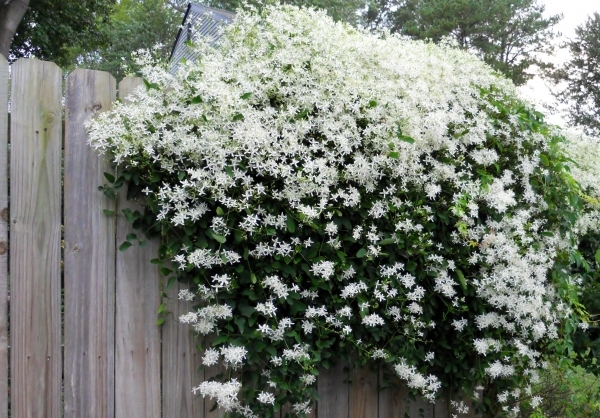 Sweet Autumn Clematis ( clematis terniflora ) and your worries are over. They are a gorgeous sight now covered in pure white, lightly fragrant flowers. Later in the fall the vine will become a silvery mass of fluffy seed heads. This small-flowered species looks impressive covering an upscale arbor or even embellishing a plain fence of garden shed. It blooms on new growth so you can easily keep it in check by cutting stems back to 12" in the spring. It will bloom well in partial shade, too.
Sweet Autumn Clematis ( clematis terniflora ) and your worries are over. They are a gorgeous sight now covered in pure white, lightly fragrant flowers. Later in the fall the vine will become a silvery mass of fluffy seed heads. This small-flowered species looks impressive covering an upscale arbor or even embellishing a plain fence of garden shed. It blooms on new growth so you can easily keep it in check by cutting stems back to 12" in the spring. It will bloom well in partial shade, too. 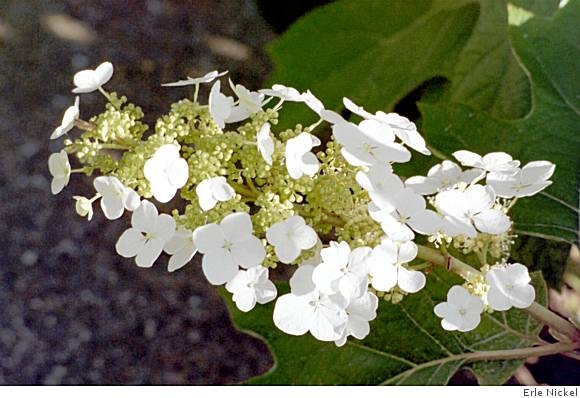 eir huge, whitish-pink conical flowers turn a papery soft tan color. In later autumn, the leaves will take on striking shades of crimson and bronze-purple, and through winter the dry flowers persist above the branches lined with exfoliating copper-brown, cinnamon and tan bark. Oakleaf hydrangeas are fast growing and accept full sun or partial shade in rich evenly moist soil. They’re real lookers in the garden.
eir huge, whitish-pink conical flowers turn a papery soft tan color. In later autumn, the leaves will take on striking shades of crimson and bronze-purple, and through winter the dry flowers persist above the branches lined with exfoliating copper-brown, cinnamon and tan bark. Oakleaf hydrangeas are fast growing and accept full sun or partial shade in rich evenly moist soil. They’re real lookers in the garden. 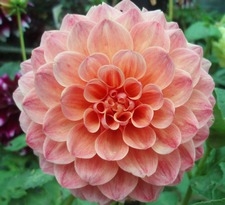
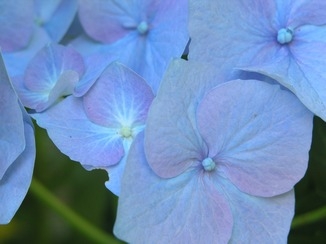 ords like cerulean, azure, cobalt, sapphire, turquoise, electric blue or steel blue when describing blue flowers. Hybridizers have tried for years to produce a true blue rose or blue daylily. Because blue plant pigment is hard to manipulate, Donald Wyman, author of Wyman’s Gardening Encyclopedia explains "Blue, since it occurs in the daylily as a sap-soluble pigment, will be difficult-perhaps impossible to segregate. Lilacs, purples, orchids, mauves we have; and working with them we may eventually get near blues, but pure blues probably never." Recently, some companies have found a way to insert some blue in the center of their daylily flowers but a totally blue daylily has never been produced.
ords like cerulean, azure, cobalt, sapphire, turquoise, electric blue or steel blue when describing blue flowers. Hybridizers have tried for years to produce a true blue rose or blue daylily. Because blue plant pigment is hard to manipulate, Donald Wyman, author of Wyman’s Gardening Encyclopedia explains "Blue, since it occurs in the daylily as a sap-soluble pigment, will be difficult-perhaps impossible to segregate. Lilacs, purples, orchids, mauves we have; and working with them we may eventually get near blues, but pure blues probably never." Recently, some companies have found a way to insert some blue in the center of their daylily flowers but a totally blue daylily has never been produced.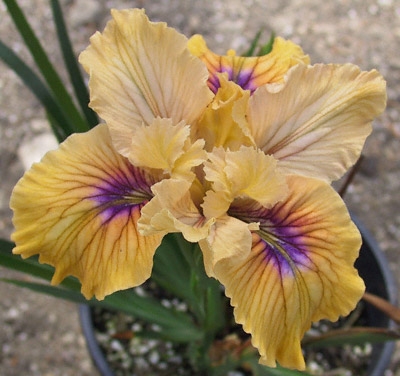 so I want to fine tune my containers and plantings so they attract as many of these small wonders as I can.
so I want to fine tune my containers and plantings so they attract as many of these small wonders as I can..jpg)
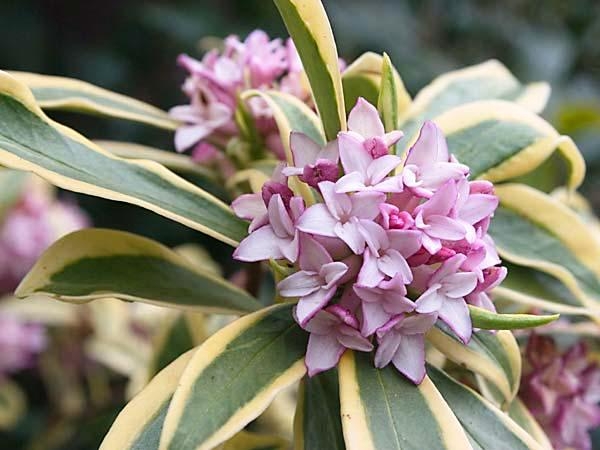 ngland called Rebecca has the same sweetly scented pink flowers but the leaves are more vividly variegated than the original. The stripes are wider and more buttery yellow and the flowers are a softer shell pink. These gorgeous little shrubs get a bad name for being finicky to grow. Less is more when it comes to their care. They thrive in partial shade in humus-rich soil with good drainage. Don’t keep them soggy during the summer or they succumb to crown and root rot. They don’t transplant well but are quite deer resistant. Daphne are not long lived, usually lasting for 8-10 years but what a life they live.
ngland called Rebecca has the same sweetly scented pink flowers but the leaves are more vividly variegated than the original. The stripes are wider and more buttery yellow and the flowers are a softer shell pink. These gorgeous little shrubs get a bad name for being finicky to grow. Less is more when it comes to their care. They thrive in partial shade in humus-rich soil with good drainage. Don’t keep them soggy during the summer or they succumb to crown and root rot. They don’t transplant well but are quite deer resistant. Daphne are not long lived, usually lasting for 8-10 years but what a life they live.